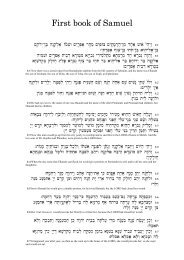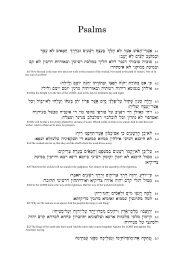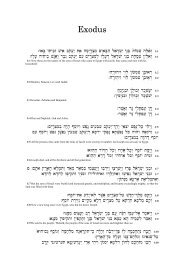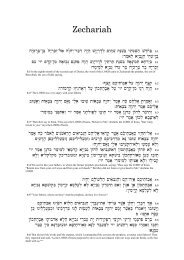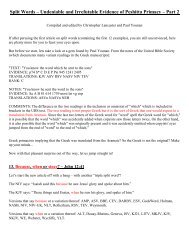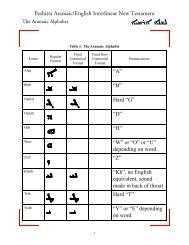ana translation
Untitled - Peshitta Aramaic/English Interlinear New Testament
Untitled - Peshitta Aramaic/English Interlinear New Testament
- No tags were found...
You also want an ePaper? Increase the reach of your titles
YUMPU automatically turns print PDFs into web optimized ePapers that Google loves.
2 PET. ii. 19] SUPPLEMENTAL NOTES. Ill<br />
supported by 12 and 18) is as adequate as OllSo to express the power<br />
by which "a man is overcome," as shown by the use of ^JOlL in the<br />
second member of the sentence to express the power by which he " is<br />
brought in bondage " (,^SV> ]jOlX = TOVTU ScScv'Aumu).<br />
Ol-^ best reproduces the symmetry of the antithetical phrase<br />
The reading<br />
of the<br />
Greek ;<br />
and seems therefore preferable to the OllLo of the majority of<br />
our codices (including 9 and 14).<br />
They are, however, countenanced by<br />
Harkl., striving laboriously as usual for accurate expression<br />
of the<br />
meaning. It may be from Harkl. that OllSo has made its way into so<br />
many of our codices ;<br />
but more probably<br />
it<br />
may have been introduced<br />
independently by some scribe in a like effort to make the sense more<br />
clear. That copyists found difficulty in understanding the passage is<br />
shown by the variations in pointing the participle PI (see note on<br />
Syr. text in loc.). If by ]>!, which 1 and 2 write, they meant present<br />
participle act. (PI), they must have misunderstood the text which (in<br />
writing OlL) they preserved as regards the letters. I write |OJ,<br />
participle pass. For a like case of doubtful pointing in these two<br />
codices, see above, Note on ii.<br />
9 (j^J).<br />
Ib. Both 1 and 2 write jdlmSi) (point on So). If by ]b\ (see last<br />
Note) these codices mean ptcp. active, they presumably intend<br />
for rOl*So, active likewise, to be distinguished from<br />
passive.<br />
But in this case, and many others of participles with LD preformative,<br />
the usage of 1 (and sometimes of 2), as regards diacritic<br />
points, is peculiar, and needs examination. The facts are as follows.<br />
(a) Whereas by ordinary usage the participles pael and aphel are<br />
distinguished as (pa.) *\&&D, (aph.) ^^^D, 1 frequently (and 2<br />
now and then) places point over the preformative So where aph. is<br />
not admissible. One such instance occurs above, ver. 14, where<br />
^^rAiO is written by 1, though the aph. of the verb ^,*<br />
use; but pa. only. Other like examples are: iii. 3,<br />
^i<br />
is not in<br />
iT"^O; iii. 13<br />
and 14,<br />
^-*M>> ; iii. 16, ^iVinsV) ; 3 Joh. 2,<br />
fl^b ; ib. 9 and 10,<br />
^nnV); Jud. 10,<br />
^.g^Vn; ib. 12, ^^D/OLD ; ib. 13, ^iO*ib.<br />
So also 2 writes ]ooSb (2 Joh. 2).<br />
None of these verbs occurs in<br />
aph. ;<br />
all occur in pa. [see<br />
Thes. Syr., under their several roots] ; except<br />
that *jJLA the aph. of ]] ,<br />
is found, though rarely ;<br />
but not in the<br />
sense of tv^o/xcu,<br />
which in the place above cited (3 Joh. 2)<br />
is as usual<br />
expressed by pa.<br />
-^r (U fcSD).



